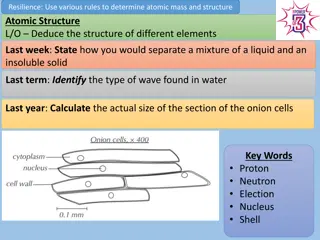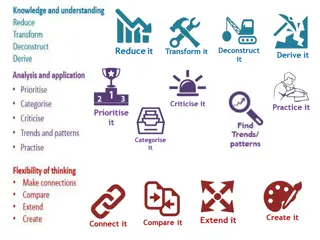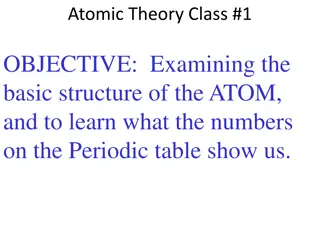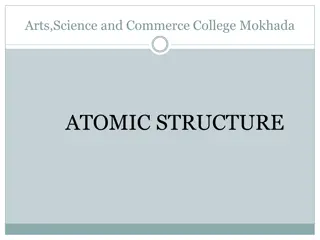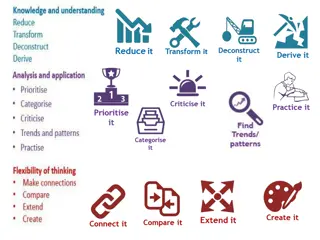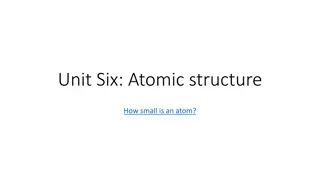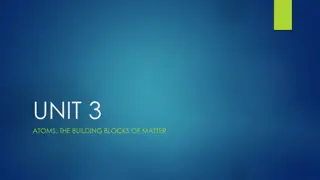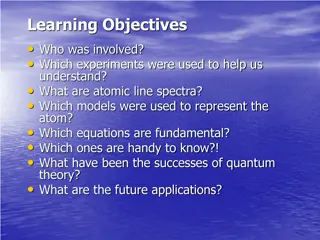Explore the History of Atomic Theory: Mid-Year Project Guidelines
Dive into the history of the atom and its significance in the scientific world through a group project that encompasses research on prominent scientists and their contributions to atomic theory. Follow guidelines for presentation and submission while delving into the fascinating journey of atomic discovery from ancient Greek philosophies to modern scientific experiments.
Uploaded on Sep 28, 2024 | 0 Views
Download Presentation

Please find below an Image/Link to download the presentation.
The content on the website is provided AS IS for your information and personal use only. It may not be sold, licensed, or shared on other websites without obtaining consent from the author. Download presentation by click this link. If you encounter any issues during the download, it is possible that the publisher has removed the file from their server.
E N D
Presentation Transcript
NO ELECTRONIC DEVICES ARE TO BE USED TODAY PERIOD! HAVE A SEAT ONCE THE TARDY BELL RINGS NO MORE TALKING CHEMISTRY 1ST, 5TH, & 7TH MID YEAR PROJECT MRS. S. DUKES
FORM GROUPS OF 4 OR 5 BE SURE TO PICK PARTNERS THAT WILL WORK. AT THIS TIME YOU SHOULD BE SITTING TOGETHER WRITE DOWN ALL GROUP MEMBERS ON A SHEET OF PAPER AND TURN IN.
GUIDELINES START DATE: DEC. 4TH DUE DATE: DEC. 10TH by 11:50p PRESENTATIONS: WEEK OF DEC. 11TH SUBMISSION: Using your school e-mail to- rousesh@boe.Richmond.k12.ga.us subject- Team# Scientist & Class Period
HISTORY OF THE ATOM The atomic theory of matter is an excellent illustration of the process of science. Our understanding of the world around us is reshaped and refined with each scientific experiment. The first recorded idea of the atom comes from the ancient Greeks in the 400 s B.C. Over the millennia, scientific experimentation has added to our knowledge of the atom, redefining what it is and what its structure is like. In this project, your goal will be to learn about some of the highlights in the history of atomic theory to gain an appreciation of how we know what we know about atoms.
STEP 1 Step one of this process involves research. Listed below are 14 scientists who all contributed to our current understanding of the atom. Your group will be assigned 1 scientist to research. Democritus Antoine Lavoisier John Dalton J. J. Thomson Ernest Rutherford Robert Millikan Marie Curie James Chadwick Max Planck Albert Einstein Niels Bohr Louis De Broglie Erwin Schrodinger Werner Heisenberg
POWERPOINT Research Guide Scientist Name When did they live? Where did they live? What new information did they contribute to the understanding of the atom? How did they find this new information? (What experiments did they do?) Description of experimental design to understand the nuclear atom Interesting facts other accomplishments, personal information, famous historical events at the time, etc. Compare & Contrast your scientist to one of the other scientist from the list.
POWERPOINT GUIDELINES 8-12 SLIDES NAMES OF GROUP MEMBERS GROUP NUMBER SCIENTIST NAME CLASS PERIOD LINKS USED FOR RESEARCH
5 4 3 2 1 Content is inaccurate and information is not presented in a logical order, making it difficult to follow Content is Accurate and information is presented in a logical order Content is accurate but some information is not presented in a logical order, but is still generally easy to follow Presentation flows well. Tools used correctly. Correct number of slides. Overall presentation is interesting Content is accurate but information is not presented in a logical order, making it difficult to follow. Presentation flows well. Some tools used to show acceptable understanding. Correct number of slides. Content is questionable and information is not presented in a logical order, making it difficult to follow. Presentation is unorganized. Tools are not used in a relevant manner. Lacking in number of slides. Content RUBRIC Presentation has no flow. No tools used. Insufficient number of slide Presentation flows well and logically. Presentation reflects extensive use of tools in a creative way. Correct number of slides. Slide creation Many spelling errors and/or text is copied. No spelling or grammar errors. Apparent that students wrote information in their own words A few spelling and/or grammar errors. Apparent that students wrote information in their own words Some spelling and/or grammar errors. Apparent that students wrote information in their own words Some spelling and/or grammar errors. Students wrote most of the information in their own words Mechanics Images are appropriate. Layout of images is pleasing to the eye. Images are appropriate. Layout is cluttered. Most images are appropriate. Images are inappropriate. No images. Creativity
R.A.F.T. STEP 2 Step 2 of this project is turning your research into an interesting an informative project. This is the part where you use the information, making sure to avoid plagiarism by putting things into your own words. The type of project you will complete is called a RAFT (R = role, A = audience, F = Format, T = Topic).
ROLE AUDIENCE FORMAT TOPIC Science Writer at the New York Times Reader of the New York Times Science Section Series of Newspaper Articles The Ongoing discovery of the atom Author Students in our class Graphic Novel Adventures of 2 or more Scientists listed above that includes their contribution to atomic development Video-Game Developer Head Game Developers of Nintendo or Sony Illustrated proposal for a new video game (don t forget to name your game) A video game that will teach high school students about atomic theory Science Historian Students studying atomic history Detailed Timeline Important Figures and Events in the History of Atomic Structure Actors putting on a performance for the scientists at the CHEM Laboratory. Scientists in the research community who are currently doing research on subatomic particles Role-Playing You will take on the persona of at least two to the scientists who contributed to the development of the atom
Newspaper articles You could write one article on your scientist. Make sure your writing is interesting; your reader shouldn t want to put the newspaper down after the first few sentences. Make sure to use newspaper article format and be creative. (Read a science article perhaps for a better understanding of this.) Timelines Your timeline should be visually attractive and include pictures of each scientist as well as descriptions of their contributions to atomic theory. Organization and attractive layout are key. Graphic Novel You should write an illustrated story. Don t forget a cover with the title of your novel. Remember, you need to make an interesting narrative that students would like to read that still includes all the required content. Turn your research into a story! Video Game Proposal Imagine you have to pitch a new video game to Nintendo or Sony. This is the proposal you would bring with you. It should outline the type of game, the objective of the game, and describe how the game is played. It should include some illustrated frames of what the game will look like on screen. Be creative about how you can incorporate learning atomic theory into a game! Remember, your proposal should make Nintendo or Sony want to make and sell your game. Role Playing Take on the persona of the scientists. You will give your performance to the scientists in our class. Be creative and fully take on the role of the scientists you have chosen. Limit the performance to 3-5 minutes.
Exceptional Good Acceptable Needs Work No Evidence RUBRIC Content: 4 3 2 1 0 You have clearly and reasonably addressed. You have included as part of your project information about each research question for scientist. Coverage of Your Specific Format/Topic: Work is creative and shows good incorporative of facts in your given format. Your project meets all the requirements for your chosen RAFT. RAFT Presentation: Neat, organized has limited errors. Shows your best possible effort and is quality work. Bibliography: citations are properly formatted, multiple sources are used, source selection is good, internet sites are reliable/well chosen 4 3 2 1 0 4 3 2 1 0 4 3 2 1 0
MEMBER GRADING 1 3 5 Does not contribute to discussion. Shows little interest Sometimes participates during the activity. Needs to be reminded to stay on task. Always participates during the activity. Shows interest and is eager to answer questions. 5 Always cooperates with group members. CONTRIBUTIONS TO GROUP 1 3 Does not cooperate with group members Sometimes cooperates with other group members. WORKS COOPERATIVELY 1 3 5 Does not complete the assignment. Completes some of the assignment Completes all of the assignment in a satisfactory manner. TASK COMPLETETION






